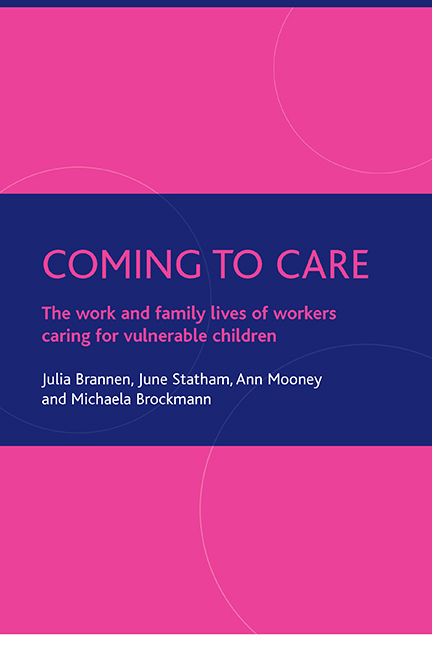Book contents
- Frontmatter
- Contents
- List of tables and boxes
- Acknowledgements
- one Setting the scene
- two The study
- three The origins of a care ethic in care workers’ childhoods
- four Entering care work with vulnerable children
- five Care workers’ careers and identities: change and continuity
- six What do vulnerable children need? Understandings of care
- seven Experiences of care work
- eight Leavers, movers and stayers
- nine Managing care work and family life
- ten Conclusions and policy implications
- Appendix: Boxes and additional tables
- References
- Index
one - Setting the scene
Published online by Cambridge University Press: 15 September 2022
- Frontmatter
- Contents
- List of tables and boxes
- Acknowledgements
- one Setting the scene
- two The study
- three The origins of a care ethic in care workers’ childhoods
- four Entering care work with vulnerable children
- five Care workers’ careers and identities: change and continuity
- six What do vulnerable children need? Understandings of care
- seven Experiences of care work
- eight Leavers, movers and stayers
- nine Managing care work and family life
- ten Conclusions and policy implications
- Appendix: Boxes and additional tables
- References
- Index
Summary
The people who work with children are central to keeping them safe and helping them to get the most out of life. (HM Government, 2003, p 10)
Introduction
This book is about the work and family lives of people who provide care for ‘vulnerable’ children and young people. This includes children who are looked after by the state in either foster families or residential children's homes, and children living in their own families but receiving additional support from social services. Such workers form part of the ‘social care workforce’, a term that is difficult to pin down and define (Eborall, 2005; Moss et al, 2006). It has been argued that the concept of social care transcends many conceptual dichotomies: between the public and private; between formal and informal settings; between paid and unpaid carers; between the state and the family; and between the care of children and of adults (Daly and Lewis, 1999). The Commission for Social Care Inspection, which has a duty to report annually on the state of social care services in England, covers within its remit both services for adults (such as care homes and domiciliary care services for older people, services for adults with learning or physical disabilities, and social work and mental health services for adults) and services for children (including social work, child protection, early years, children's homes, and fostering and adoption services). In 2004/05, the total social care workforce was estimated to number around 1.6 million people, with 13% of them working in children's services. The majority of workers (85%) were female, and nearly two thirds were employed in the private and voluntary sector (CSCI, 2005a).
The children's workforce has received particular attention from central government in recent years, partly as a result of childcare scandals that have focused attention on failures among those working with vulnerable children (Laming, 2003). The Every Child Matters: Change for Children programme (HM Government, 2003) has made ‘workforce reform’ a key area for action. Subsequent developments have included the publication of a Children's Workforce Strategy, which aims to ‘build a world-class workforce for children and young people’ (HM Government, 2005a), and the creation of a Children's Workforce Development Council in 2005 to take this work forward.
- Type
- Chapter
- Information
- Coming to CareThe Work and Family Lives of Workers Caring for Vulnerable Children, pp. 1 - 14Publisher: Bristol University PressPrint publication year: 2007



